
2018/4/27 园上清大华 Overview of Lectures 国上清大学 0.Overview 14/15 Performance(a,b) 16.Aircraft certification 2.Overall configuration 17.Aviation economics weight estimation 18.System integration and configuration management Aircraft Design estimation Fuselage design 19.Multidisciplinary design (飞行器设计) 6/7/8 Aerodynamic design(a,b,c) ootimization .hat and ing 20.Military aircraft design-overview 21.Environmental issues 10.Landing gear and Aircraft systems 22.Desian skills Wenbin Song 11.Power plant School of Aeronautics and Astronautics 12.Stability and control Shanghai Jiao Tong University 13.Loads,materials and structures swb@sjtu.edu.cn oorornenin ong Content 圆上清文大些 Overview 国上清大坐 Overview Stable-natural or artificial Definition and types of stability (static and dynamic) Controllable -position and orientation-flight path Stability analysis Good flying qualities -reduce pilot workloads Aircraft control system Configuration Historical development Sizing of tails using Flight dynamics -Active control system volume coefficients in analysis using 6 DOF Aerodynamics Aircraft flying qualities conceptual designs system Weight and Future trends balances Solution of Propulsion equations of motion Aircraft Linearized equation performance methods Modern feedback control orn enn ong Stability and Control vs Performance Analysis 国圆上清发大坐 Three types of stability 图上活大坐 Aircraft performance Three types of static stability-reflects how the Point of mass assumption aircraft responds to disturbance or pilot inputs -Trajectory is of interests -The tendency of how the aircraft would respond In stability analysis,aircraft is a six-degree-of-freedom (DOF)system,while in performance analysis,aircraft is treated as a mass point. 7777777777 Aircraft stability and control -Body (rigid) unstable Indifferent stability -Orientation aircraft is of more interests Shanghai Tong university-Dr.Wenbin Song 1
2018/4/27 1 © Shanghai Jiao Tong University – Dr. Wenbin Song School of Aeronautics and Astronautics Aircraft Design (飞行器设计) 1 Wenbin Song School of Aeronautics and Astronautics Shanghai Jiao Tong University swb@sjtu.edu.cn © Shanghai Jiao Tong University – Dr. Wenbin Song School of Aeronautics and Astronautics Overview of Lectures 0. Overview 1. Introduction 2. Overall configuration 3. Preliminary weight estimation 4. Refined weight estimation 5. Fuselage design 6/7/8 Aerodynamic design(a, b, c) 9. Thrust/Weight ratio and wing loading 10.Landing gear and Aircraft systems 11.Power plant 12.Stability and control 13.Loads, materials and structures 14/15 Performance(a, b) 16.Aircraft certification 17.Aviation economics 18.System integration and configuration management 19.Multidisciplinary design optimization 20.Military aircraft design – overview 21.Environmental issues 22.Design skills © Shanghai Jiao Tong University – Dr. Wenbin Song School of Aeronautics and Astronautics Content • Overview • Definition and types of stability (static and dynamic) • Stability analysis • Aircraft control system – Historical development – Active control system • Aircraft flying qualities • Future trends 3 © Shanghai Jiao Tong University – Dr. Wenbin Song School of Aeronautics and Astronautics Overview • Stable – natural or artificial • Controllable – position and orientation – flight path • Good flying qualities – reduce pilot workloads 4 Sizing of tails using volume coefficients in conceptual designs Flight dynamics analysis using 6 DOF system Solution of equations of motion Linearized equation methods Aerodynamics Propulsion Aircraft performance Modern feedback control Weight and balances Configuration © Shanghai Jiao Tong University – Dr. Wenbin Song School of Aeronautics and Astronautics Stability and Control vs. Performance Analysis • Aircraft performance – Point of mass assumption – Trajectory is of interests 5 • Aircraft stability and control – Body (rigid) – Orientation aircraft is of more interests In stability analysis, aircraft is a six-degree-of-freedom (DOF) system, while in performance analysis, aircraft is treated as a mass point. © Shanghai Jiao Tong University – Dr. Wenbin Song School of Aeronautics and Astronautics Three types of stability • Three types of static stability – reflects how the aircraft responds to disturbance or pilot inputs – The tendency of how the aircraft would respond 6 unstable Indifferent stability stable
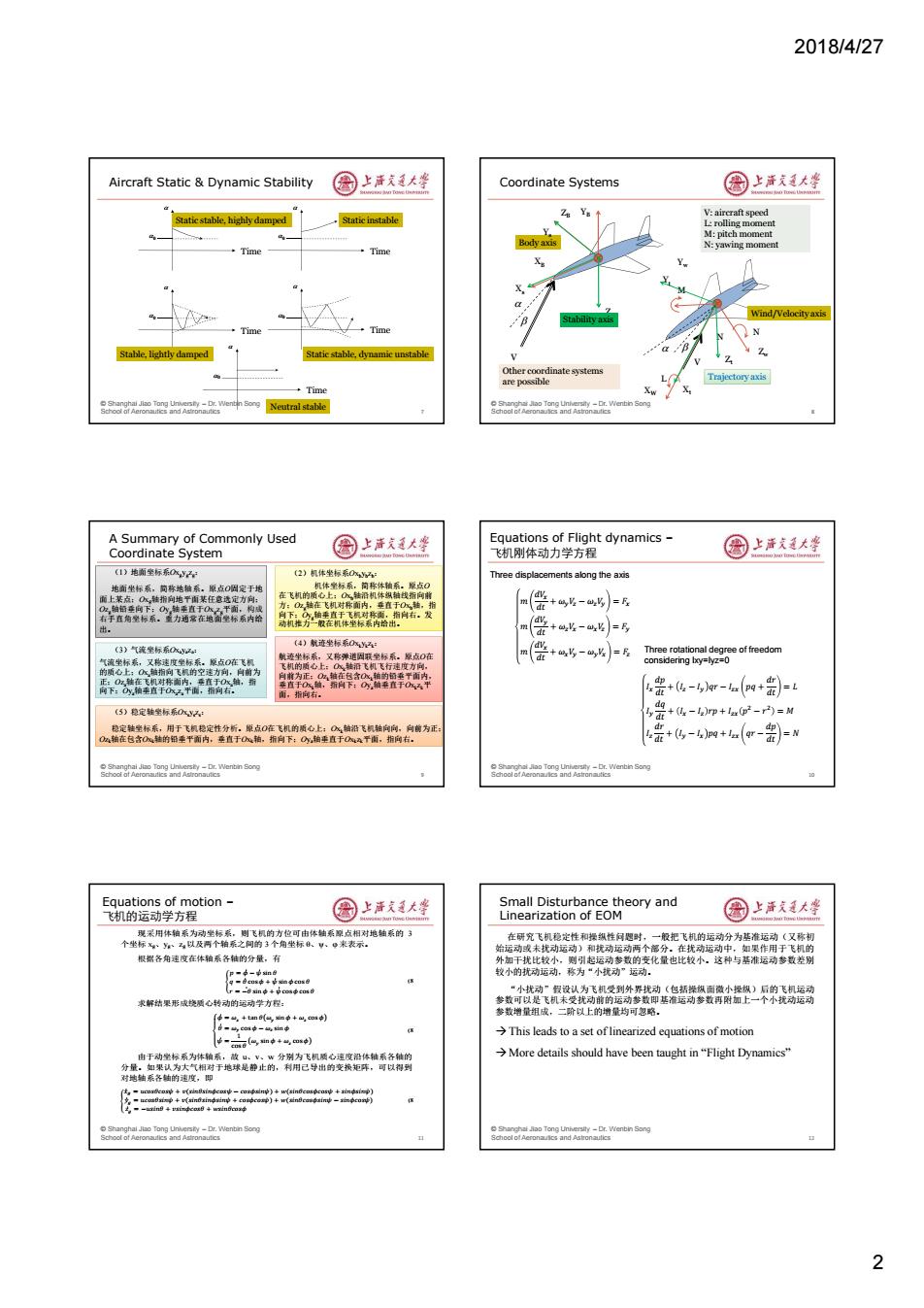
2018/4/27 Aircraft Static Dynamic Stability 图上声文大些 Coordinate Systems 国上清大学 Static stable.highly damped Staticinstable V:aireraft speed L:rolling moment Body axis M:pitch moment Time Time N:yawing moment Stability axi Wind/Velocityaxis Tim .Time Stable,lightly dampec Static stable,dynamic unstable Other coordinate systems are possible Trajectory axis Time Xw Neutral stable ong A Summary of Commonly Used Coordinate System 国上活大坐 Equations of Flight dynamics- 飞机刚体动力学方程 圆上洋文廷大蜂 1)地南坐标系0,y (2)机体坐标系Ox: Three displacements along the axis 地面坐标系,前称地轴系。原点O周定于地 机体坐标系,简称体轴系。原点0 面上某点:0,轴指向地子面某任意透定力向: 在飞机的质心上:O入轴沿机体纵轴战折向前 力:0,轴在飞机对称面内,垂直于O轴,指 (偎+s%-g- 出。 偿+g--g (3)气液坐标系0xyz: (4)航迹坐标系0子: 迹坐标系,又此弹推因理华标系,题点0在 老:为 n(偎+sy-y)-发e 飞机的质心上:O入鞋沿飞机飞行速度方向。 considering lxy=lyz=0 垂直于O轴,指 面。指向右 贵+-4r-a+)= 《5)稳定鞋坐标系0人 +化-0p+a-内=M 发心标系,用于飞机稳定性分析。原点0在 轴沿飞轴向向 :限0流机的 +6-网+(-)- dr Equations of motion- 飞机的运动学方程 国上清大学 Small Disturbance theory and Linearization of EOM 园上海发大坐 现采用体铂系为动坐标系。则飞机的方位可由体轴系腺点相对地轴系的3 个坐标无、、乙以及两个轴系之间的3个角坐标:、、●来表示。 在研究飞机稳定性和操纵性问恩时,一般把飞机的运动分为基准运动(又称初 始运动或未扰动运动)和扰动运动两个部分,在扰动运动中,如果作用于飞机的 根据各角速度在体轴系各轴的分量,有 外加干扰比较小,则引起运动参数的变化量也比较小。这种与基准运动参数差别 较小的扰动运动,称为“小扰动”运动。 “小扰动”程设认为飞机受到外界扰动(包括操纵面微小操纵)后的飞机运动 求解结果形成绕质心转动的运动学方程: 参数可以是飞机未受扰动前的运动参数即基准运动参数再附上一个小扰动运动 参数增量组成,二阶以上的增量均可忽略 >This leads to a set of linearized equations of motion →More details should have been taught in“Flight Dynamics'” ersty-Dr.Wenbin Song rslty-Dr.V(enbin Song 2
2018/4/27 2 © Shanghai Jiao Tong University – Dr. Wenbin Song School of Aeronautics and Astronautics Aircraft Static & Dynamic Stability 7 0 Time 0 Time 0 Time 0 Time 0 Time Static stable, highly damped Static instable Stable, lightly damped Static stable, dynamic unstable Neutral stable © Shanghai Jiao Tong University – Dr. Wenbin Song School of Aeronautics and Astronautics Coordinate Systems 8 XB ZB YB V XW Zw Yw V Body axis Wind/Velocity axis L M N N V: aircraft speed L: rolling moment M: pitch moment N: yawing moment Other coordinate systems are possible Xs Zs Stability axis Ys Xt Zt Trajectory axis Yt © Shanghai Jiao Tong University – Dr. Wenbin Song School of Aeronautics and Astronautics A Summary of Commonly Used Coordinate System 9 (1)地面坐标系Oxg yg zg : 地面坐标系,简称地轴系。原点O固定于地 面上某点;Oxg 轴指向地平面某任意选定方向; Ozg 轴铅垂向下;Oyg 轴垂直于Oxg zg 平面,构成 右手直角坐标系。重力通常在地面坐标系内给 出。 (2)机体坐标系Oxb yb zb : 机体坐标系,简称体轴系。原点O 在飞机的质心上;Oxb 轴沿机体纵轴线指向前 方;Ozg 轴在飞机对称面内,垂直于Oxb 轴,指 向下;Oyg 轴垂直于飞机对称面,指向右。发 动机推力一般在机体坐标系内给出。 (3)气流坐标系Oxaya za : 气流坐标系,又称速度坐标系。原点O在飞机 的质心上;Oxa 轴指向飞机的空速方向,向前为 正;Oza 轴在飞机对称面内,垂直于Oxa 轴,指 向下;Oya 轴垂直于Oxa za 平面,指向右。 (4)航迹坐标系Oxk yk zk : 航迹坐标系,又称弹道固联坐标系。原点O在 飞机的质心上;Oxk 轴沿飞机飞行速度方向, 向前为正;Ozk 轴在包含Oxk 轴的铅垂平面内, 垂直于Oxk 轴,指向下;Oya 轴垂直于Oxk zk 平 面,指向右。 向前为正; (5)稳定轴坐标系Oxsyszs : 稳定轴坐标系,用于飞机稳定性分析。原点O在飞机的质心上;Oxk 轴沿飞机轴向向,向前为正; Ozk 轴在包含Oxk 轴的铅垂平面内,垂直于Oxk 轴,指向下;Oya 轴垂直于Oxk zk 平面,指向右。 © Shanghai Jiao Tong University – Dr. Wenbin Song School of Aeronautics and Astronautics Equations of Flight dynamics – 飞机刚体动力学方程 10 𝑚 𝑑𝑉௫ 𝑑𝑡 + 𝜔௬𝑉௭ − 𝜔௭𝑉௬ = 𝐹௫ 𝑚 𝑑𝑉௬ 𝑑𝑡 + 𝜔௭𝑉௫ − 𝜔௫𝑉௭ = 𝐹௬ 𝑚 𝑑𝑉௫ 𝑑𝑡 + 𝜔௫𝑉௬ − 𝜔௬𝑉௫ = 𝐹௭ 𝐼௫ 𝑑𝑝𝑑𝑡 + 𝐼௭ − 𝐼௬ 𝑞𝑟 − 𝐼௭௫ 𝑝𝑞 + 𝑑𝑟𝑑𝑡 = 𝐿 𝐼௬ 𝑑𝑞𝑑𝑡 + 𝐼௫ − 𝐼௭ 𝑟𝑝 + 𝐼௭௫ 𝑝ଶ − 𝑟ଶ = 𝑀 𝐼௭ 𝑑𝑟𝑑𝑡 + 𝐼௬ − 𝐼௫ 𝑝𝑞 + 𝐼௭௫ 𝑞𝑟 − 𝑑𝑝𝑑𝑡 = 𝑁 Three displacements along the axis Three rotational degree of freedom considering Ixy=Iyz=0 © Shanghai Jiao Tong University – Dr. Wenbin Song School of Aeronautics and Astronautics Equations of motion – 飞机的运动学方程 11 现采用体轴系为动坐标系,则飞机的方位可由体轴系原点相对地轴系的 3 个坐标 xg、yg、zg以及两个轴系之间的 3 个角坐标 θ、ψ、φ 来表示。 根据各角速度在体轴系各轴的分量,有 ቐ 𝑝 = 𝜙̇ − 𝜓̇ sin 𝜃 𝑞 = 𝜃̇ cos𝜙 + 𝜓̇ sin 𝜙cos 𝜃 𝑟 = −𝜃̇ sin 𝜙 + 𝜓̇ cos𝜙 cos 𝜃 (8 求解结果形成绕质心转动的运动学方程: ⎩ ⎪ ⎨ ⎪ ⎧𝜙̇ = 𝜔𝑥 + tan 𝜃൫𝜔𝑦 sin 𝜙 + 𝜔𝑧 cos 𝜙൯ 𝜃̇ = 𝜔𝑦 cos 𝜙 − 𝜔𝑧 sin𝜙 𝜓̇ = 1 cos 𝜃 ൫𝜔𝑦 sin𝜙 + 𝜔𝑧 cos𝜙൯ (8 由于动坐标系为体轴系,故 u、v、w 分别为飞机质心速度沿体轴系各轴的 分量。如果认为大气相对于地球是静止的,利用已导出的变换矩阵,可以得到 对地轴系各轴的速度,即 ቐ 𝑥̇𝑔 = 𝑢𝑐𝑜𝑠𝜃𝑐𝑜𝑠𝜓 + 𝑣(𝑠𝑖𝑛𝜃𝑠𝑖𝑛𝜙𝑐𝑜𝑠𝜓 − 𝑐𝑜𝑠𝜙𝑠𝑖𝑛𝜓) + 𝑤(𝑠𝑖𝑛𝜃𝑐𝑜𝑠𝜙𝑐𝑜𝑠𝜓 + 𝑠𝑖𝑛𝜙𝑠𝑖𝑛𝜓) 𝑦̇𝑔 = 𝑢𝑐𝑜𝑠𝜃𝑠𝑖𝑛𝜓 + 𝑣(𝑠𝑖𝑛𝜃𝑠𝑖𝑛𝜙𝑠𝑖𝑛𝜓 + 𝑐𝑜𝑠𝜙𝑐𝑜𝑠𝜓) + 𝑤(𝑠𝑖𝑛𝜃𝑐𝑜𝑠𝜙𝑠𝑖𝑛𝜓 − 𝑠𝑖𝑛𝜙𝑐𝑜𝑠𝜓) 𝑧𝑔̇ = −𝑢𝑠𝑖𝑛𝜃 + 𝑣𝑠𝑖𝑛𝜙𝑐𝑜𝑠𝜃 + 𝑤𝑠𝑖𝑛𝜃𝑐𝑜𝑠𝜙 (8 © Shanghai Jiao Tong University – Dr. Wenbin Song School of Aeronautics and Astronautics Small Disturbance theory and Linearization of EOM 12 在研究飞机稳定性和操纵性问题时,一般把飞机的运动分为基准运动(又称初 始运动或未扰动运动)和扰动运动两个部分。在扰动运动中,如果作用于飞机的 外加干扰比较小,则引起运动参数的变化量也比较小。这种与基准运动参数差别 较小的扰动运动,称为“小扰动”运动。 “小扰动”假设认为飞机受到外界扰动(包括操纵面微小操纵)后的飞机运动 参数可以是飞机未受扰动前的运动参数即基准运动参数再附加上一个小扰动运动 参数增量组成,二阶以上的增量均可忽略。 This leads to a set of linearized equations of motion More details should have been taught in “Flight Dynamics

2018/4/27 Stability and Control Related 图上唐大学 Aircraft Control Surfaces Components 国上清大学 The following aircraft component/systems are important in aircraft stability and control -Weight and balance -Tall design -Control surfaces -Aerodynamic design Design criteria -Stability and control system meet the mission SPEED requirements G5钟0aa5 -Specifications on handling qualities are given in various standards GJB185-86(military aircraft) FAA/EASA/CAA Certification(civil aircraft) CONTROL SURFACES -LEAPNG EDGE FLAPS Intemet picture Stability Analysis 国上活大峰 Longitudinal and Lateral Stability 国上活大坐 Most aircraft are symmetrical,therefore: ·Pitch moment Stability analysis decoupled into ·Yaw moment -Longitudinal analysis (pitch only) A Lateral-directional analysis(roll and yaw) Static and Dynamic stability -Static stability provides the first step for achieving reasonable flying qualities Features of static instability can provide enhanced manoeuvrability -Dynamic stability is important to handling quality m■m0w-C,(X-X) oernan Wen ong 参考资料:顾通芬,飞机息体授计。 Moment coefficients 国上清大学 Linear Approximation of Moment Coefficients 图上活大坐 Moment coefficients are defined as Using first-order Taylor series expansion Cm =M/aSc Cn N/qSb C L/qSb Cm=Cmo+Cma园+Cms.园+Cmh where,and b are the MAC (mean aerodynamic chord)and wing span AAelevator deflection incidence of horitontal stabilizer Stability analysis is mainly concerned with aircraft response to changes in angular orientation CL=C1o+CigB+Cm5g8a+Cms,8r as sta Cn Cno+CneB+Cnoad+Cno.6 Cma Cig Cng side slip angle aileron deflection rudder deflection These explains the concept of stability coefficients 3
2018/4/27 3 © Shanghai Jiao Tong University – Dr. Wenbin Song School of Aeronautics and Astronautics Stability and Control Related Components • The following aircraft component/systems are important in aircraft stability and control – Weight and balance – Tail design – Control surfaces – Aerodynamic design • Design criteria – Stability and control system meet the mission requirements – Specifications on handling qualities are given in various standards • GJB185-86 (military aircraft) • FAA/EASA/CAA Certification (civil aircraft) 13 © Shanghai Jiao Tong University – Dr. Wenbin Song School of Aeronautics and Astronautics Aircraft Control Surfaces 14 Internet picture © Shanghai Jiao Tong University – Dr. Wenbin Song School of Aeronautics and Astronautics Stability Analysis • Most aircraft are symmetrical, therefore: • Stability analysis decoupled into – Longitudinal analysis (pitch only) – Lateral-directional analysis (roll and yaw) • Static and Dynamic stability – Static stability provides the first step for achieving reasonable flying qualities – Features of static instability can provide enhanced manoeuvrability – Dynamic stability is important to handling quality 15 © Shanghai Jiao Tong University – Dr. Wenbin Song School of Aeronautics and Astronautics Longitudinal and Lateral Stability • Pitch moment • Yaw moment 16 参考资料:顾诵芬,飞机总体设计 © Shanghai Jiao Tong University – Dr. Wenbin Song School of Aeronautics and Astronautics Moment coefficients • Moment coefficients are defined as 𝐶 = 𝑀/𝑞𝑆𝑐̅ 𝐶 = 𝑁/𝑞𝑆𝑏 𝐶 = 𝐿/𝑞𝑆𝑏 • where, 𝑐̅and 𝑏 are the MAC (mean aerodynamic chord) and wing span • Stability analysis is mainly concerned with aircraft response to changes in angular orientation – Derivatives of these coefficients w.r.t. AOA and sideslip angle are therefore referred to as stability derivatives 𝐶ഀ , 𝐶ഁ , 𝐶ഁ 17 © Shanghai Jiao Tong University – Dr. Wenbin Song School of Aeronautics and Astronautics Linear Approximation of Moment Coefficients • Using first-order Taylor series expansion • These explains the concept of stability coefficients 18 AOA elevator deflection incidence of horizontal stabilizer side slip angle aileron deflection rudder deflection
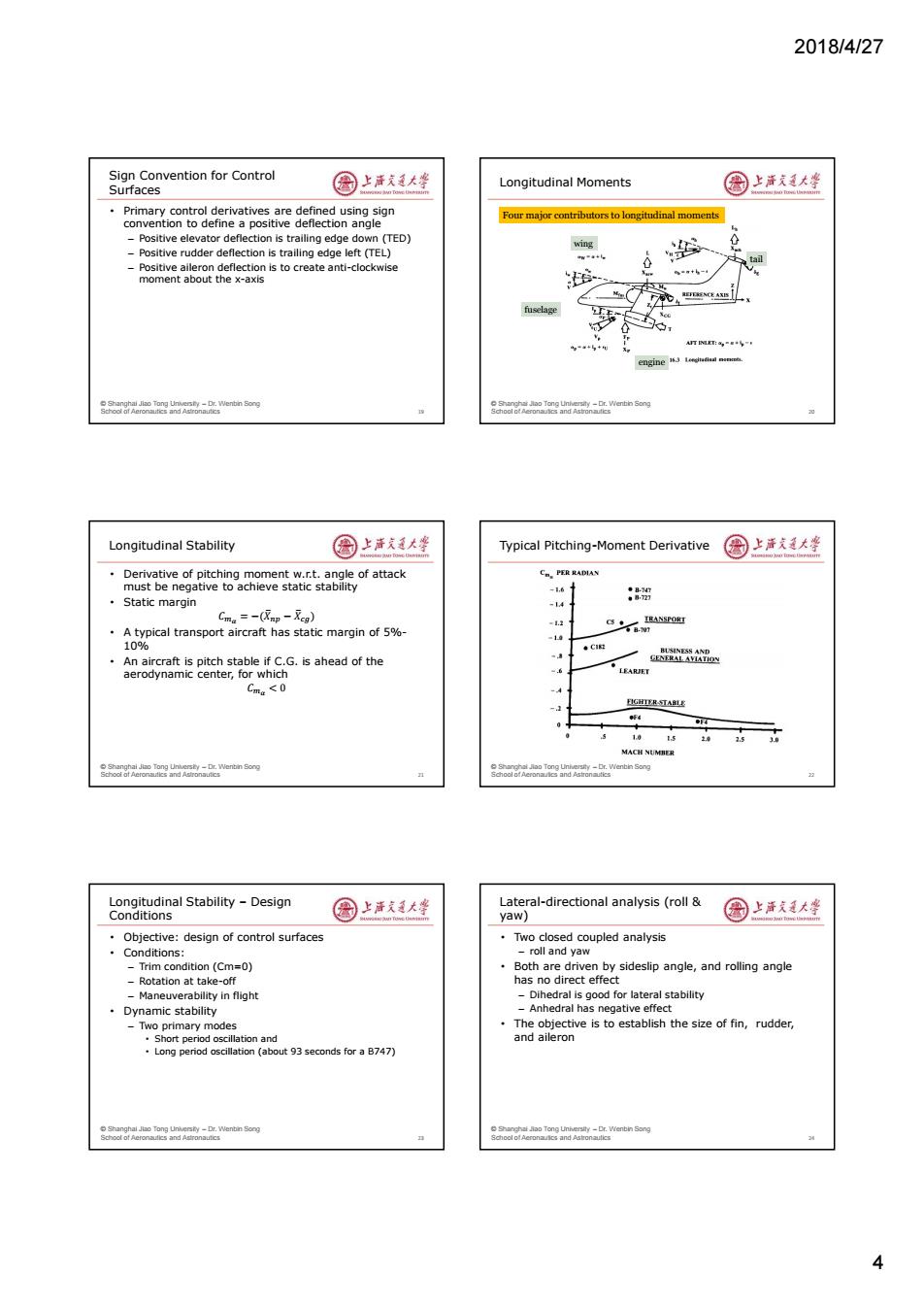
2018/4/27 Sign Convention for Control Surfaces 国上活大坐 Longitudinal Moments 国上清大学 Primary control derivatives are defined using sign Four major contributors to longitudinal moments convention to define a positive deflection angle Positive elevator deflection is trailing edge down (TED) wing Positive rudder deflection is trailing edge left (TEL) m=+人 Positive aileron deflection is to create anti-clockwise moment about the x-axis fuselage engine rrcn ein o oorn enin Song Longitudinal Stability 国上活我道大生 Typical Pitching-Moment Derivative 圆上注道大坐 Derivative of pitching moment w.r.t.angle of attack Cn.PER RADIAN must be negative to achieve static stability -6十 Static margin :滑 -14 Cm=-(区np-Xcg) -12 A typical transport aircraft has static margin of 5%- 10% g An aircraft is pitch stable if C.G.is ahead of the aerodynamic center,for which LEARJET Cma<0 EIGHTER STABLE 3.0 MACH NUMIER Longitudinal Stability -Design Lateral-directional analysis(roll Conditions 国上清大学 yaw) 国上洋大学 Objective:design of control surfaces Two closed coupled analysis Conditions: -roll and yaw -Trim condition (Cm=0) Both are driven by sideslip angle,and rolling angle -Rotation at take-off has no direct effect Maneuverability in flight Dihedral is good for lateral stability Dynamic stability Anhedral has negative effect -Two primary modes The objective is to establish the size of fin,rudder, Short period oscillation and and aileron Long period oscillation (about 93 seconds for a B747) erslty-Dr.V(enbin Song 24 4
2018/4/27 4 © Shanghai Jiao Tong University – Dr. Wenbin Song School of Aeronautics and Astronautics Sign Convention for Control Surfaces • Primary control derivatives are defined using sign convention to define a positive deflection angle – Positive elevator deflection is trailing edge down (TED) – Positive rudder deflection is trailing edge left (TEL) – Positive aileron deflection is to create anti-clockwise moment about the x-axis 19 © Shanghai Jiao Tong University – Dr. Wenbin Song School of Aeronautics and Astronautics Longitudinal Moments 20 wing tail engine fuselage Four major contributors to longitudinal moments © Shanghai Jiao Tong University – Dr. Wenbin Song School of Aeronautics and Astronautics Longitudinal Stability • Derivative of pitching moment w.r.t. angle of attack must be negative to achieve static stability • Static margin 𝐶ഀ = −(𝑋ത − 𝑋ത) • A typical transport aircraft has static margin of 5%- 10% • An aircraft is pitch stable if C.G. is ahead of the aerodynamic center, for which 𝐶ഀ < 0 21 © Shanghai Jiao Tong University – Dr. Wenbin Song School of Aeronautics and Astronautics Typical Pitching-Moment Derivative 22 © Shanghai Jiao Tong University – Dr. Wenbin Song School of Aeronautics and Astronautics Longitudinal Stability – Design Conditions • Objective: design of control surfaces • Conditions: – Trim condition (Cm=0) – Rotation at take-off – Maneuverability in flight • Dynamic stability – Two primary modes • Short period oscillation and • Long period oscillation (about 93 seconds for a B747) 23 © Shanghai Jiao Tong University – Dr. Wenbin Song School of Aeronautics and Astronautics Lateral-directional analysis (roll & yaw) • Two closed coupled analysis – roll and yaw • Both are driven by sideslip angle, and rolling angle has no direct effect – Dihedral is good for lateral stability – Anhedral has negative effect • The objective is to establish the size of fin, rudder, and aileron 24

2018/4/27 Major Contributors for Roll and Yaw 圈上声天大学 Typical Yaw Moment Derivatives 国上清大学 ·Engine out Vertical tail Aileron deflection 2 HAWK NAST TN D-423 LEARJET F4 25 50.75 1. 1-251.501.7520 MACH NUMBER Fig.16.20 Typlcal yaw moment derivative values. oorornenin ong n ong 国上活大峰 Aircraft Control System 园上活道大整 Aircraft control system components-overview Pilot Control system Aircraft Control Classical feedback control system Pilot ontrol system nwentin ong er-onric Aircraft Control Surfaces 国圆上清发大坐 Development of Aircraft Control Systems (A) 园上海发大坐 Pitch control A:direct mechanical link Roll contro aw contro ·Features: Direct "force feedback" y-Dr.Wenbin Song erslty-Dr.V(enbin Song 5
2018/4/27 5 © Shanghai Jiao Tong University – Dr. Wenbin Song School of Aeronautics and Astronautics Major Contributors for Roll and Yaw 25 • Engine out • Vertical tail • Aileron deflection © Shanghai Jiao Tong University – Dr. Wenbin Song School of Aeronautics and Astronautics Typical Yaw Moment Derivatives 26 © Shanghai Jiao Tong University – Dr. Wenbin Song School of Aeronautics and Astronautics 27 Aircraft Control © Shanghai Jiao Tong University – Dr. Wenbin Song School of Aeronautics and Astronautics Aircraft Control System • Aircraft control system components - overview 28 Pilot Control system Aircraft Pilot Control system Aircraft Classical feedback control system Modern computer-centric control system © Shanghai Jiao Tong University – Dr. Wenbin Song School of Aeronautics and Astronautics Aircraft Control Surfaces 29 Pitch control Yaw control Roll control © Shanghai Jiao Tong University – Dr. Wenbin Song School of Aeronautics and Astronautics Development of Aircraft Control Systems (A) • A: direct mechanical link • Features: – Direct “force feedback” 30
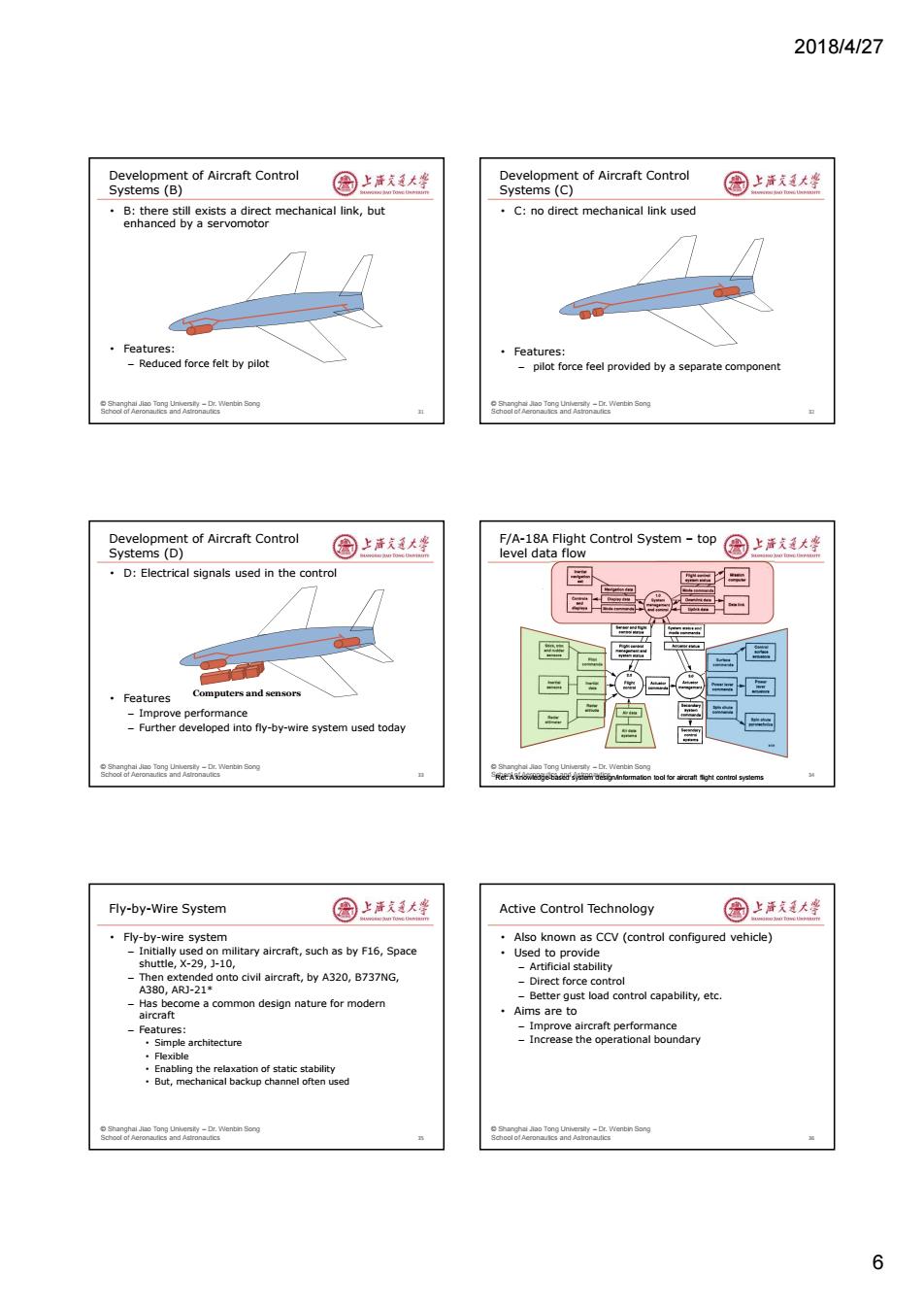
2018/4/27 Development of Aircraft Control Systems(B) 国上活大坐 Development of Aircraft Control Systems(C) 国上清大学 B:there still exists a direct mechanical link,but C:no direct mechanical link used enhanced by a servomotor ·Features: ·Features: Reduced force felt by pilot pilot force feel provided by a separate component Development of Aircraft Control F/A-18A Flight Control System-top Systems (D) 圆上活文通大孝 level data flow 圈上活大整 D:Electrical signals used in the control ·Features Computers and sensors -Improve performance Further developed into fly-by-wire system used today Fly-by-Wire System 图上洋大峰 Active Control Technology 图上活大坐 ·Fly-by-wire system Also known as CCV(control configured vehicle) Initially used on military aircraft,such as by F16,Space ·Used to provide shuttle,X-29,J-10, Artificial stability Then extended onto civil aircraft,by A320,B737NG, -Direct force control A380,ARJ-21* -Has become a common design nature for modern -Better gust load control capability,etc. aircraft ·Aims are to -Features: -Improve aircraft performance ·Simple architecture -Increase the operational boundary ·Flexible Enabling the relaxation of static stability But,mechanical backup channel often used erslty-Dr.V(enbin Song 6
2018/4/27 6 © Shanghai Jiao Tong University – Dr. Wenbin Song School of Aeronautics and Astronautics Development of Aircraft Control Systems (B) • B: there still exists a direct mechanical link, but enhanced by a servomotor • Features: – Reduced force felt by pilot 31 © Shanghai Jiao Tong University – Dr. Wenbin Song School of Aeronautics and Astronautics Development of Aircraft Control Systems (C) • C: no direct mechanical link used • Features: – pilot force feel provided by a separate component 32 © Shanghai Jiao Tong University – Dr. Wenbin Song School of Aeronautics and Astronautics Development of Aircraft Control Systems (D) • D: Electrical signals used in the control • Features – Improve performance – Further developed into fly-by-wire system used today 33 Computers and sensors © Shanghai Jiao Tong University – Dr. Wenbin Song School of Aeronautics and Astronautics F/A-18A Flight Control System – top level data flow 34 Ref: A knowledge-based system design/information tool for aircraft flight control systems © Shanghai Jiao Tong University – Dr. Wenbin Song School of Aeronautics and Astronautics Fly-by-Wire System • Fly-by-wire system – Initially used on military aircraft, such as by F16, Space shuttle, X-29, J-10, – Then extended onto civil aircraft, by A320, B737NG, A380, ARJ-21* – Has become a common design nature for modern aircraft – Features: • Simple architecture • Flexible • Enabling the relaxation of static stability • But, mechanical backup channel often used 35 © Shanghai Jiao Tong University – Dr. Wenbin Song School of Aeronautics and Astronautics Active Control Technology • Also known as CCV (control configured vehicle) • Used to provide – Artificial stability – Direct force control – Better gust load control capability, etc. • Aims are to – Improve aircraft performance – Increase the operational boundary 36
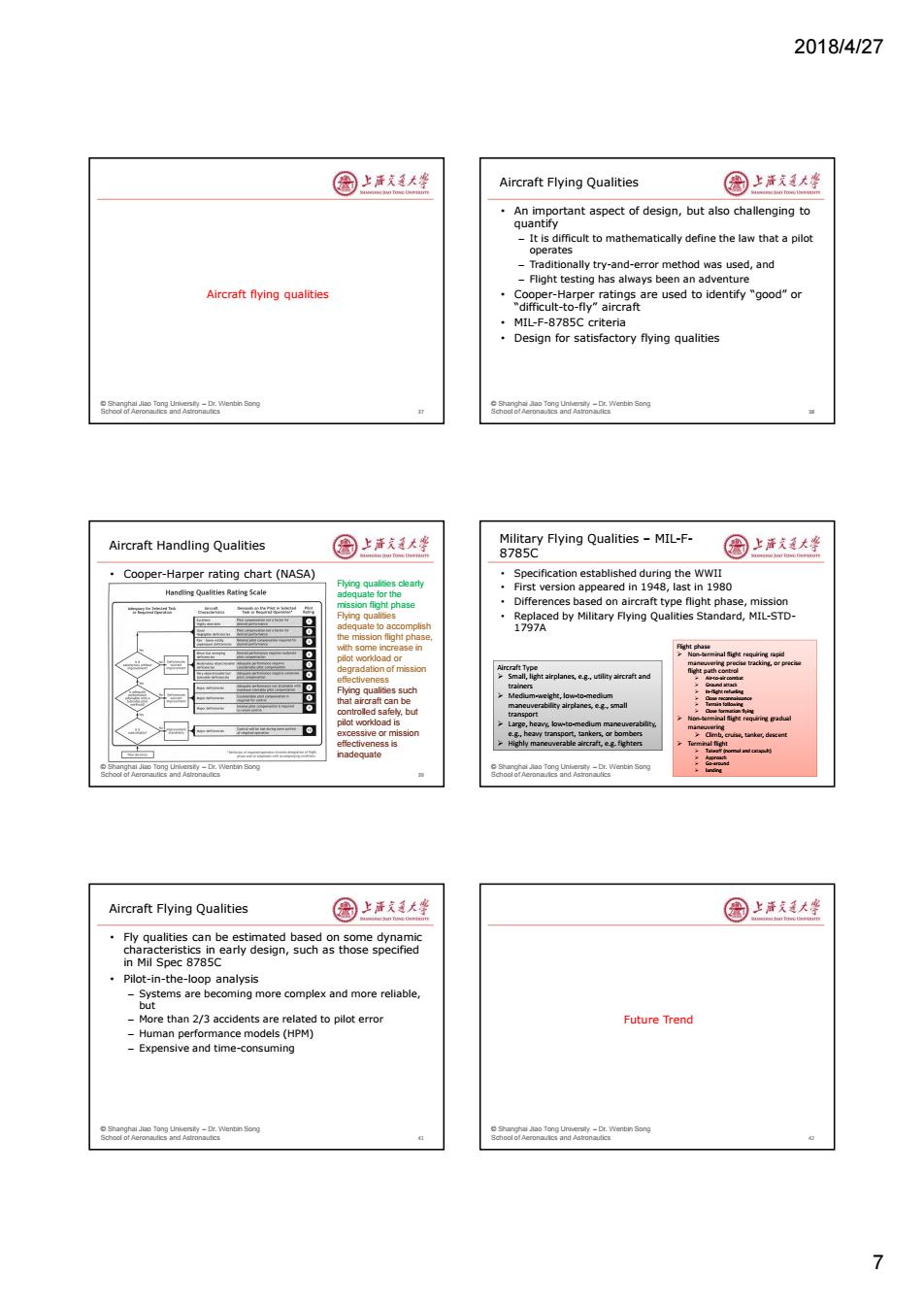
2018/4/27 圆上清文大华 Aircraft Flying Qualities 国上洋文大坐 An important aspect of design,but also challenging to quantify It is difficult to mathematically define the law that a pilot operates -Traditionally try-and-error method was used,and -Flight testing has always been an adventure Aircraft flying qualities Cooper-Harper ratings are used to identify "good"or "difficult-to-fly"aircraft MIL-F-8785C criteria Design for satisfactory flying qualities 8ge2-weno网 oorn enin Song Aircraft Handling Qualities 圈上活大坐 Military Flying Qualities-MIL-F- 8785C 园上活道大整 Cooper-Harper rating chart(NASA) Specification established during the WWII Flying qualities clearty Handing Qulities Rating Scale adequate for the First version appeared in 1948,last in 1980 mission flight phase Differences based on aircraft type flight phase,mission Flying qualites Replaced by Military Flying Qualities Standard,MIL-STD- 1797A the mission flight phase. Mith some increase in ollot workload or of mission Alrcraft Type Small,light airplanes,e.gutility arcraft and but ”L,heav%wtom iad effectiveness is Aircraft Flying Qualities 图上洋大峰 园上海发大坐 Fly qualities can be estimated based on some dynamic characteristics in early design,such as those specified in Mil Spec 8785C Pilot-in-the-loop analysis -Systems are becoming more complex and more reliable, but More than 2/3 accidents are related to pilot error Future Trend Human performance models(HPM) Expensive and time-consuming 7
2018/4/27 7 © Shanghai Jiao Tong University – Dr. Wenbin Song School of Aeronautics and Astronautics 37 Aircraft flying qualities © Shanghai Jiao Tong University – Dr. Wenbin Song School of Aeronautics and Astronautics Aircraft Flying Qualities • An important aspect of design, but also challenging to quantify – It is difficult to mathematically define the law that a pilot operates – Traditionally try-and-error method was used, and – Flight testing has always been an adventure • Cooper-Harper ratings are used to identify “good” or “difficult-to-fly” aircraft • MIL-F-8785C criteria • Design for satisfactory flying qualities 38 © Shanghai Jiao Tong University – Dr. Wenbin Song School of Aeronautics and Astronautics Aircraft Handling Qualities • Cooper-Harper rating chart (NASA) 39 Flying qualities clearly adequate for the mission flight phase Flying qualities adequate to accomplish the mission flight phase, with some increase in pilot workload or degradation of mission effectiveness Flying qualities such that aircraft can be controlled safely, but pilot workload is excessive or mission effectiveness is inadequate © Shanghai Jiao Tong University – Dr. Wenbin Song School of Aeronautics and Astronautics Military Flying Qualities – MIL-F- 8785C • Specification established during the WWII • First version appeared in 1948, last in 1980 • Differences based on aircraft type flight phase, mission • Replaced by Military Flying Qualities Standard, MIL-STD- 1797A 40 Aircraft Type Small, light airplanes, e.g., utility aircraft and trainers Medium-weight, low-to-medium maneuverability airplanes, e.g., small transport Large, heavy, low-to-medium maneuverability, e.g., heavy transport, tankers, or bombers Highly maneuverable aircraft, e.g. fighters Flight phase Non-terminal flight requiring rapid maneuvering precise tracking, or precise flight path control Air-to-air combat Ground attack In-flight refueling Close reconnaissance Terrain following Close formation flying Non-terminal flight requiring gradual maneuvering Climb, cruise, tanker, descent Terminal flight Takeoff (normal and catapult) Approach Go-around landing © Shanghai Jiao Tong University – Dr. Wenbin Song School of Aeronautics and Astronautics Aircraft Flying Qualities • Fly qualities can be estimated based on some dynamic characteristics in early design, such as those specified in Mil Spec 8785C • Pilot-in-the-loop analysis – Systems are becoming more complex and more reliable, but – More than 2/3 accidents are related to pilot error – Human performance models (HPM) – Expensive and time-consuming 41 © Shanghai Jiao Tong University – Dr. Wenbin Song School of Aeronautics and Astronautics 42 Future Trend
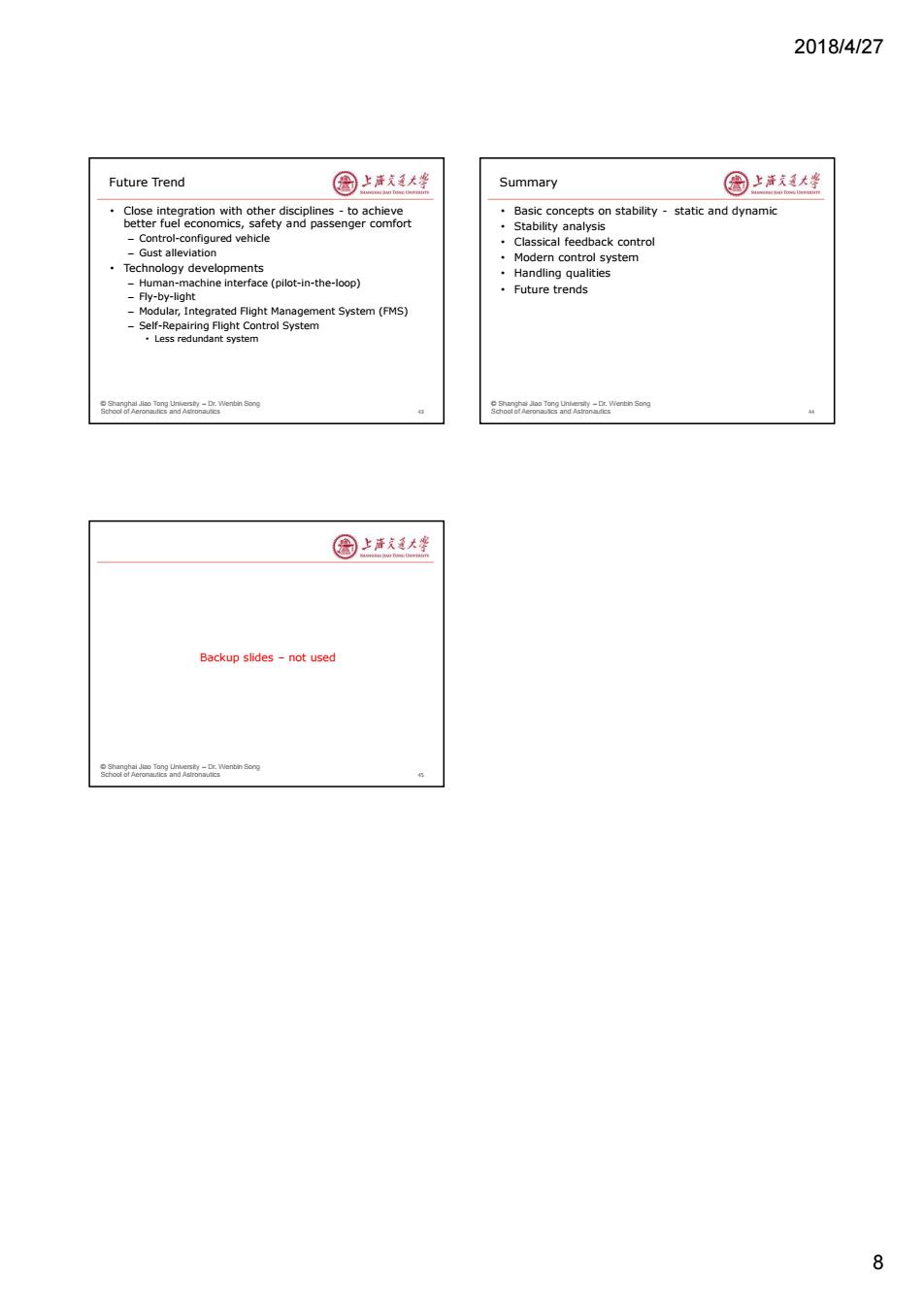
2018/4/27 Future Trend 国上唐美大坐 Summary 国上清大学 Close integration with other disciplines-to achieve Basic concepts on stability-static and dynamic better fuel economics,safety and passenger comfort ·Stability analysis -Control-configured vehicle Classical feedback control Gust alleviation Modern control system Technology developments ·Handling qualities Human-machine interface(pilot-in-the-loop) Fly-by-light ·Future trends Modular,Integrated Flight Management System(FMS) Self-Repairing Flight Control System Less redundant system oorornenin ong orn enin Song 国上清大坐 Backup slides-not used nwentin ong 8
2018/4/27 8 © Shanghai Jiao Tong University – Dr. Wenbin Song School of Aeronautics and Astronautics Future Trend • Close integration with other disciplines - to achieve better fuel economics, safety and passenger comfort – Control-configured vehicle – Gust alleviation • Technology developments – Human-machine interface (pilot-in-the-loop) – Fly-by-light – Modular, Integrated Flight Management System (FMS) – Self-Repairing Flight Control System • Less redundant system 43 © Shanghai Jiao Tong University – Dr. Wenbin Song School of Aeronautics and Astronautics Summary • Basic concepts on stability - static and dynamic • Stability analysis • Classical feedback control • Modern control system • Handling qualities • Future trends 44 © Shanghai Jiao Tong University – Dr. Wenbin Song School of Aeronautics and Astronautics 45 Backup slides – not used